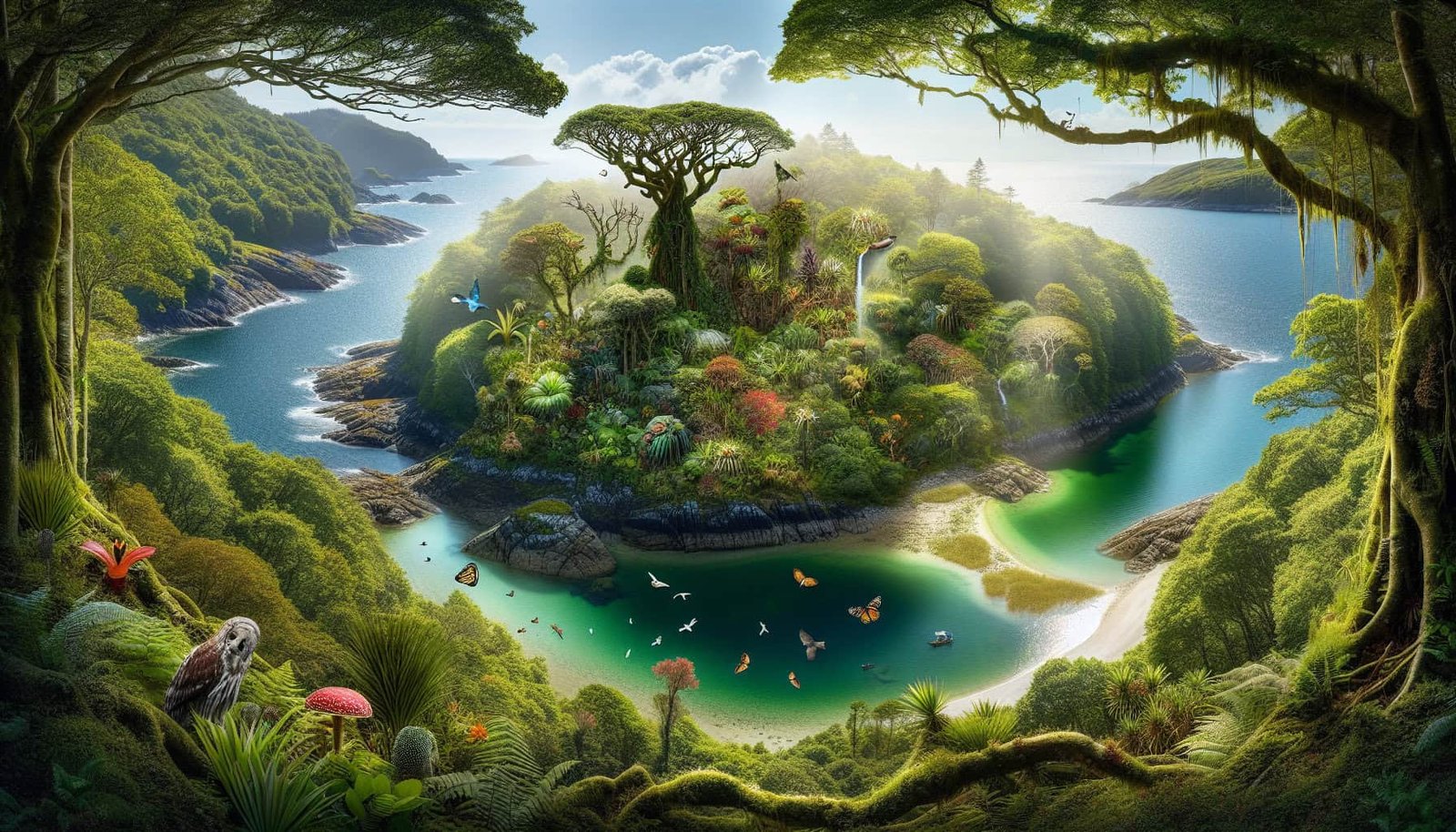Imagine embarking on a journey to explore hidden havens where endangered wildlife thrives amongst untouched landscapes. These off-the-beaten-path wildlife sanctuaries, tucked away from bustling cities and tourist hotspots, are the unsung heroes of conservation efforts. Within their tranquil confines, they provide vital support and protection to endangered species, allowing them to flourish and reclaim their rightful place in the natural world. In this article, we will uncover the lesser-known sanctuaries that serve as safe havens for these magnificent creatures, their unique features, and the remarkable conservation efforts being undertaken within their boundaries. Get ready to be amazed by the resilience of wildlife and the remarkable individuals working tirelessly to preserve their existence.

Sanctuary A: Location and Description
Sanctuary A is located in the remote highlands of South America, nestled among towering mountains and lush forests. It covers thousands of acres of pristine wilderness, making it an ideal habitat for a diverse range of endangered species. The sanctuary is known for its breathtaking views and untouched natural beauty. It is home to endangered species such as the Andean condor, the spectacled bear, and the giant otter. The sanctuary offers various hiking trails and guided tours, allowing visitors to appreciate the magnificent wildlife and immerse themselves in nature.
Sanctuary B: Location and Description
Located in the heart of the African savannah, Sanctuary B is a haven for endangered species in one of the most biodiverse regions on the planet. This expansive sanctuary spans vast grasslands and mighty rivers. Visitors can witness the majesty of iconic African animals such as elephants, rhinos, and lions. The sanctuary’s dedicated conservation efforts focus on protecting these species from poaching, habitat loss, and other threats. Educational programs and guided safaris provide visitors with a deeper understanding of the importance of conservation and the challenges faced by endangered wildlife in this unique ecosystem.
Sanctuary C: Location and Description
Sanctuary C is nestled within a dense tropical rainforest in Southeast Asia, boasting an extraordinary range of biodiversity. It is home to countless endangered species, including the orangutan, the Sumatran tiger, and the pygmy elephant. In this sanctuary, visitors have the opportunity to witness these remarkable creatures in their natural habitat. Guided tours and immersive experiences provide a glimpse into the daily lives of these endangered animals, and conservation efforts focus on protecting the rainforest and combating illegal logging and poaching activities.
Sanctuary D: Location and Description
Situated in the vast expanse of the Australian Outback, Sanctuary D offers a unique sanctuary experience. This arid landscape is home to several endangered species that have adapted to survive in the harsh desert conditions. Visitors can observe rare creatures such as the bilby, the marsupial mole, and the purple-crowned fairy-wren. The sanctuary actively monitors and protects these species from threats such as habitat degradation and invasive species. Guided tours offer insight into the resilience of Australia’s unique wildlife and the conservation efforts dedicated to their survival.

Sanctuary E: Location and Description
Sanctuary E lies in the remote reaches of the Amazon rainforest, one of the most biodiverse regions on Earth. This sanctuary encompasses vast hectares of dense, untouched jungle, providing a safe haven for endangered species such as the jaguar, the giant anteater, and the Amazon river dolphin. Visitors can embark on guided boat tours, allowing them to witness the incredible biodiversity of the rainforest and understand the critical importance of preserving these fragile ecosystems. Conservation efforts focus on combatting illegal activities, such as deforestation and wildlife trafficking, that threaten the delicate balance of the Amazon.
Sanctuary F: Location and Description
Located in the rugged mountains of New Zealand, Sanctuary F offers a haven for unique and endangered species found nowhere else on Earth. This sanctuary is home to iconic creatures such as the kiwi bird, the kea parrot, and the takahe. Visitors can explore the diverse landscapes of the sanctuary through guided hikes and interactive exhibits, gaining insight into the conservation challenges faced by these endemic species. Efforts are focused on eradicating invasive species, restoring native habitats, and raising awareness about the importance of preserving New Zealand’s unique biodiversity.

Sanctuary G: Location and Description
Sanctuary G is nestled along the coastline of a remote island in the Pacific Ocean. This marine sanctuary serves as a vital refuge for endangered marine species such as sea turtles, coral reefs, and Hawaiian monk seals. Visitors can partake in snorkeling and scuba diving excursions to witness the vibrant underwater ecosystems the sanctuary protects. Conservation efforts involve monitoring water quality, enforcing fishing regulations, and educating visitors about sustainable practices to preserve the fragile marine habitats within the sanctuary.
Sanctuary H: Location and Description
Sanctuary H is situated in the pristine forests of North America, encompassing vast stretches of old-growth trees and hidden lakes. This sanctuary provides vital habitat for endangered species such as the gray wolf, the bald eagle, and the grizzly bear. Guided hikes and wildlife observation platforms allow visitors to appreciate the beauty and fragility of these ecosystems. Conservation efforts focus on protecting and reconnecting fragmented habitats, mitigating human-wildlife conflicts, and promoting sustainable forestry practices to ensure the long-term survival of these iconic North American species.

Sanctuary I: Location and Description
Sanctuary I is located in the remote islands of the South Pacific, offering a sanctuary for endangered marine and avian species. This tropical paradise is home to unique creatures such as the Fiji banded iguana, the Fijian monkey-faced bat, and the Fiji petrel. Visitors can explore the pristine beaches and crystal-clear waters while learning about the delicate balance of marine and terrestrial ecosystems. Conservation efforts revolve around marine protected areas, invasive species control, and fostering community stewardship to safeguard the biodiversity of these island ecosystems.
Sanctuary J: Location and Description
Sanctuary J is situated in the rugged wilderness of the Arctic tundra, providing a refuge for endangered species adapted to extreme cold climates. This sanctuary is home to the polar bear, the Arctic fox, and the snowy owl, among others. Visitors can embark on guided expeditions to witness the awe-inspiring beauty of the Arctic and learn about the conservation challenges presented by climate change and melting sea ice. Efforts are focused on reducing carbon emissions, advocating for wildlife-friendly policies, and raising awareness about the interconnectedness of these unique ecosystems.

Conservation Efforts in the Sanctuaries
1. Commitment to Protecting Endangered Species
All the sanctuaries mentioned above share a common commitment to protecting endangered species. They recognize the importance of biodiversity and the need to safeguard these unique animals for future generations. Through comprehensive conservation strategies, they aim to mitigate threats and create a safe haven for endangered species to thrive.
2. Habitat Restoration Programs
One of the core conservation efforts in these sanctuaries is habitat restoration. By restoring and preserving critical habitats, such as rainforests, grasslands, and coral reefs, these sanctuaries provide essential resources for endangered species. Through reforestation, invasive species management, and coral reef preservation projects, they aim to recreate and maintain healthy ecosystems.
3. Captive Breeding and Reintroduction Initiatives
Sanctuaries actively engage in captive breeding and reintroduction programs to bolster endangered species populations. These initiatives involve breeding endangered animals in a controlled environment and later releasing them into the wild with the hope of establishing self-sustaining populations. By ensuring genetic diversity and reducing the risk of extinction, sanctuaries contribute to the recovery of endangered species.
4. Community Engagement and Education
Community engagement and education programs play a crucial role in the conservation efforts of these sanctuaries. By involving local communities and raising awareness about the value of biodiversity and sustainable practices, they foster a sense of stewardship towards the environment. Education initiatives, guided tours, and outreach programs ensure that visitors and locals alike understand the importance of protecting endangered species.
5. Collaborative Conservation Partnerships
Sanctuaries recognize that effective conservation requires collaboration. They establish partnerships with governmental agencies, non-profit organizations, and local communities to combine resources and expertise. Through these collaborative efforts, they can implement comprehensive conservation strategies, pool funding for projects, and ensure long-term sustainability.
6. Sustainable Tourism Practices
Sustainable tourism practices are an integral part of the sanctuaries’ conservation efforts. By promoting responsible tourism, these sanctuaries minimize the environmental impact of visitors while providing economic benefits to local communities. Eco-friendly lodging, waste management systems, and guided tours that prioritize wildlife conservation enable visitors to appreciate the sanctuaries’ beauty without compromising their long-term sustainability.
7. Scientific Research and Monitoring
Scientific research and monitoring are crucial components of the sanctuaries’ conservation efforts. By collecting data on endangered species populations, behavior, and habitats, they gain insights into the challenges faced by these animals. This information allows them to adapt conservation strategies, track the success of reintroduction programs, and monitor the overall health of ecosystems.
8. Policies and Regulations
To protect and conserve endangered species, sanctuaries work hand in hand with local and national authorities to establish policies and regulations. These policies aim to address issues such as poaching, habitat destruction, and illegal wildlife trade. By enforcing stringent regulations and advocating for stronger conservation laws, sanctuaries strive to create a legal framework that supports their efforts.
9. Fundraising and Support
Conservation efforts require substantial financial resources, and sanctuaries actively engage in fundraising and seeking support from governments, philanthropic organizations, and individuals passionate about wildlife conservation. These funds enable the sanctuaries to invest in infrastructure, research, education programs, and hiring dedicated staff members who work tirelessly to protect endangered species.
10. Success Stories and Challenges
The sanctuaries have witnessed remarkable success stories in the protection and recovery of endangered species. Their efforts have led to the recovery of populations, expansion of species’ ranges, and the prevention of extinction for many species. However, numerous challenges persist, including habitat fragmentation, climate change, and human-wildlife conflicts. Each sanctuary actively works to address these challenges, adapting their conservation strategies and collaborating with experts to ensure the long-term sustainability of these fragile ecosystems.
Impact on Endangered Species
1. Recovery of Species Population
By providing a safe haven and implementing conservation efforts, sanctuaries have played a pivotal role in the recovery of endangered species populations. These sanctuaries have observed significant increases in population numbers, offering hope for the survival and future sustainability of these species.
2. Expansion of Species’ Range
The conservation efforts within these sanctuaries have allowed for the expansion of species’ ranges. By providing protected habitats and addressing threats, the sanctuaries have created conditions that allow endangered species to recolonize areas they once inhabited, spreading their range and increasing their chances of survival.
3. Protection of Critical Habitats
Sanctuaries have succeeded in ensuring the protection of critical habitats for endangered species. By managing and preserving these habitats, they provide the necessary resources, such as food, shelter, and breeding grounds, to support the survival of these species.
4. Creating Corridors for Migration
Many sanctuaries actively work to create corridors, connecting fragmented habitats for migrating species. These corridors allow endangered animals to move between areas, promoting genetic diversity and enhancing their long-term survival prospects.
5. Preventing Extinction
Sanctuaries have played a crucial role in preventing the extinction of various endangered species. By actively protecting and managing populations, implementing breeding programs, and addressing threats, sanctuaries have succeeded in reversing the decline of many species on the brink of extinction.
6. Enhancing Biodiversity
The conservation efforts undertaken by sanctuaries contribute to enhancing overall biodiversity within the ecosystems they protect. By protecting endangered species, sanctuaries indirectly safeguard other species that depend on these ecosystems, creating a more resilient and balanced natural environment.
7. Ecosystem Restoration
The sanctuaries’ conservation efforts involve ecosystem restoration, which has far-reaching effects beyond the survival of endangered species. By restoring degraded habitats, sanctuaries help to rebuild complex ecological relationships, promote healthy functioning ecosystems, and ensure the survival of keystone species.
8. Threat Mitigation
Sanctuaries play a significant role in mitigating threats to endangered species. Whether it be poaching, habitat loss, or climate change, sanctuaries actively implement strategies to address these threats, reducing the harm inflicted upon endangered species and working towards their long-term conservation.
9. Conservation Awareness
Through educational programs and community engagement, sanctuaries raise awareness about the importance of conservation and the plight of endangered species. By fostering a sense of connection and understanding, they inspire individuals to take action and become advocates for wildlife protection.
10. Long-Term Sustainability
Ultimately, the impact of sanctuaries on endangered species lies in their long-term sustainability. By implementing comprehensive conservation efforts, engaging in scientific research, and collaborating with stakeholders, sanctuaries strive to secure a future where endangered species can thrive for generations to come.
In conclusion, off-the-beaten-path sanctuaries are making tremendous efforts to support endangered species. Through their commitment to protection, habitat restoration programs, captive breeding initiatives, community engagement, and education, they work tirelessly to mitigate threats and ensure the survival of these remarkable creatures. The impact of these sanctuaries is far-reaching, ranging from the recovery of species populations to the enhancement of overall biodiversity and the prevention of extinction. As we continue to recognize the importance of preserving our planet’s precious wildlife, supporting and visiting these sanctuaries can make a significant difference in securing a future where endangered species can thrive in their natural habitats.
